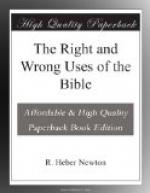It is a most interesting study to place these great prophets in their chronological order, and trace the development of this ethical religion. As one after another they come upon the stage of action they take up the great words of their masters and repeat them in their own way; take up the great tasks of their predecessors and carry them on toward completion; leading religion into an ever deepening spirituality. The prophets of the eighth century group around Isaiah, under whose influence Hezekiah attempted a partial reformation of the popular religion. The prophets of the seventh century group around Jeremiah, the master-spirit in the more thorough reformation carried out under Josiah. This second reformation achieved an institutional organization of ethical religion, that came just in time to create a body capable of holding the people together in loyalty to the true God, amid the break up of the nation.
V.
The Epoch of the Exile: B.C. 586-536.
The conquest of the two sister kingdoms, with the carrying away of the influential portion of the people into exile, was a blessing in disguise. Israel was taken out of its petty provincialisms, its race insularity, and placed amid one of the most highly cultivated civilizations of the ancient world. The fertile plain of Mesopotamia had been from immemorial antiquity the seat of great enterprises. Civilization had developed there when surrounding peoples had not emerged from semi-barbarism. Like the Troy beneath Troy in the Ilium ruins, we find here successive civilizations resting each upon the debris of an earlier order. The descriptions of ancient historians, together with the explorations of late years, make very vivid the scenes amid which the captive Israelites walked.
Babylon was a city which might well astonish and captivate strangers. It was of immense size, being surrounded by a wall forty, or possibly sixty, miles in circumference. This wall was nearly three hundred feet high, and was broad enough to allow a chariot with four horses to turn easily upon it. The streets were wide and straight, crossing each other at right angles, and were lined with houses several stories in height, painted in all the colors of the rainbow. Trees and gardens were so plentiful as to give the whole city the appearance of a park. The grounds of the imperial palace covered an area of seven miles round, in the centre of the city. The largest temple the world has ever seen rose in pyramidal form six hundred feet in air. The broad and shaded streets were resplendent with the pomp and pageantry of the court of a mighty empire, and were alive with the bustle of the traffic of the known world.
Libraries and museums garnered the treasures of art and literature, of science and philosophy, accumulated through centuries. On every hand were the tokens of a refined and cultivated civilization, venerable with age. In the temples a rich ritual celebrated an elaborate worship, while learned priests waited to explain the profound philosophic and poetic truths of the sacred symbols.




